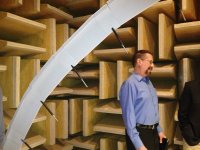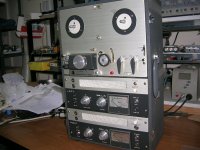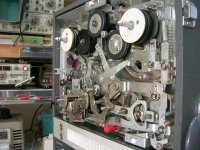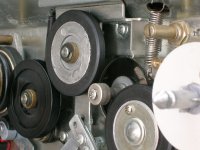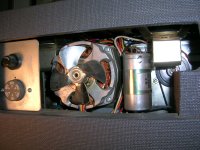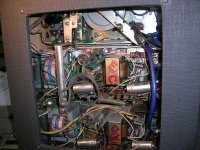Yes, most of usual instruments play tones (not overtones) below 100 Hz.
We can see how different are subjective views of the individual members.
Excellent graph - well done, Pavel!
It is quite clear on the fact that even human voise reaches down to 60 Hz. When you own a pair of dinky li'l loudspeakers, with a 7" "bass/mid" driver, what you get at 60 Hz is "bass & mud".
And even if, by some freak chance, it gets down as low as 55 Hz, can you imagine what its 60 Hz reproduction is like? What with phase shifts and all?
Junk!
If it isn't at least a 3 way speaker, with serious optimization of the drivers' work bandwidth and sensitivity equalization, I see no way it can ever be more than a Low Fi unit. Of curse, we all know that just installing the drivers doesn't really mean much if the rest has been "forgotten", usually for reasons of price constraints and chasing "perceived value".
Sorry Frank, but that's how I see things after all these years. To me, anybody who's happy with a PC as his prime music source either doesn't give diddley for music and just wants a sound blanket to cover the silence, or has badly and sadly lacking hearing.
Double that if his speakers are those godawful plastic perversions of speakers, strictly active and costing no more than $50. They do not recreate music, they create noise, acting as music-to-noise converters. If they weren't made of plastic, they would probably have tubes inside and be called Ultra Fi, at the princely sum of $70.
At the risk of being called an elitist, I will say this: once anything is adopted by the masses, it will be perverted to whatever beyond recognition. This is what's killing quality audio.
But the logic is inescapable - 1 billion each paying just $5 are worth more than 10,000 paying $100k each.
Hi,
...
Personally I often found the early Decca stereo recordings using a simple Blumlein mic set up to be quite realistic.
In those days a recording was a piece of art not a mere product.
Ciao, 😉
Exactly!
Once it became a popular sport, it became a commodity, which needed to be made ever more accessible by lowering its price, meaning much less expensive studio work, less soud planning, less technology put to good use, less vinyl and ever more rare printing press services.
I will try mono after Jan sets up his TT ........... 😀
The thing is, as SY alluded to elsewhere, after having experienced the pleasures of surround over headphones with the Smyth Realiser A8 (heavily DSP'ed of course), I find it difficult to imagine how this can be fitted in a standard living room.
A simple example: suppose you know someone who has a very good listening room, and someone else (maybe yourself) who has a pair of very good speakers (or even a single very good speaker).
With a few hours of time you can 'record' the acoustic signature of a) the listening room, b) the speaker as it plays in that room, and c) your ears and your headphones' transfer function.
From there on, ALL music you listen to will sound as if it is reproduced in that room over those speakers, mono, stereo or surround.
You could even take it to your fav symphony hall and record ITS acoustic signature.
After all these years, I finally found a system that lets me literally reproduce the music as if it is the original performance.
So you would think that Smyth can't make them fast enough... But no.
We are all so entrenced in our clunky limited systems we just can't get out of the rutt, sometimes literally not!
Jan
Last edited:
The thing is, as SY alluded to elsewhere, after having experienced the pleasures of surround over headphones with the Smyth Realiser A8 (heavily DSP'ed of course), I find it difficult to imagine how this can be fitted in a standard living room.
A simple example: suppose you know someone who has a very good listening room, and someone else (maybe yourself) who has a pair of very good speakers (or even a single very good speaker).
With a few hours of time you can 'record' the acoustic signature of a) the listening room, b) the speaker as it plays in that room, and c) your ears and your headphones' transfer function.
From there on, ALL music you listen to will sound as if it is reproduced in that room over those speakers, mono, stereo or surround.
You could even take it to your fav symphony hall and record ITS acoustic signature.
After all these years, I finally found a system that lets me literally reproduce the music as if it is the original performance.
So you would think that Smyth can't make them fast enough... But no.
We are all so entrenced in our clunky limited systems we just can't get out of the rutt, sometimes literally not!
Jan
Maybe so. Have you tried the same phones, without all the extra stuff, but with a genuine binaural recording? You might be surprised. That's real stereo.
If there is a chance, try to place your speakers inside a big garden - open space, almost no reflections (you will need powerful amplifiers).
If there is a chance, try to place your speakers inside a big garden - open space, almost no reflections (you will need powerful amplifiers).
Yes. Acoustic Research did something like that. They buried the speaker under test flush in the ground for 2 pi steradian anechoic testing.
Have you ever listened to music on speakers in an anechoic chamber?
It's more practical than outdoors. Every imperfection is laid bare, nothing hidden by room reflections.
To me, deadly quiet anechoic chamber is stressing.
Yes. Anechoic is about as unnatural as you can get. Your brain will hate you for it. 😉
A great way to measure - I am going into a dead room next week for some measurements.
But a b**ch for listening.
jan
Last edited:
Furtwangler's wartime Beethoven recordings?
Exactly! Never beaten for WHUUMP!
Maybe so. Have you tried the same phones, without all the extra stuff, but with a genuine binaural recording? You might be surprised. That's real stereo.
Yes some binaural recordings are good. But still no match to the A8. Even with binaural recording you have the 'in your head effect' because when you turn your head, the soundfield turns with it. Your brain, not to be fooled that easy, will conclude the sound is in your head.
The A8 uses a head tracking device that reinforces the experience, when you turn your head the processor turns the soundfield the other way so the perception is that the sound field is stationary so the brain knows it is out there and not in your head.
Jan
To me, deadly quiet anechoic chamber is stressing.
It is kind of strange.
Attachments
the church organs of Ulm, Germany, a sound and acoustics which transfixed me and nailed me to the seat for 4 hours flat, I think without breathing more than twice.
Biographical Dictionary of the Organ | Organ Specification | Cathedral, Ulm, Germany
https://ia600800.us.archive.org/8/items/organitshistoryc00hopk/organitshistoryc00hopk.pdf
I still stand by my opinion - PR99's are masquerated consumer machines with added gimmicks, nothing else.
Me too don’t like excess complexity. Simple audio electronic circuits were just fine.
I don't follow you. Care to elaborate?
The Japanese decks were made with stamped steel chassis but this didn’t cause any problem. Even with the cheap models, their capstan motors were robust servos and the reel drivers were eddy current motors, excellent for keeping constant tension and being kind to the tapes during start-stop. Heads were glass encapsulated.
Overall, no problem with the electronics, less heat build-up, stable performance over time.
That's painting with a broad brush. Which stability are you talking about? All halfway decent transports produce nice W&F figures in tests..
As long as they are RMS numbers.
Pavel showed a picture of a prof machine, where it is shown what it takes to keep the tape tensioned and positioned well on the heads.
What exactly should I check?
Peak W&F. Record the tone and replay, recording the output through the soundcard.
Wind the tape back and forth, replay and repeat the digital recording of the output.
Use new tape, otherwise the tests will be gravy from the start, tape induced W&F will override deck’s performance.
George
Some photos from a lovely archaic AKAI M8 🙂
Attachments
Last edited:
It's more that poor stereo is inferior. Most speakers are incapable of creating a properly focused image due to lack of proper driver blending, so they can't possibly do stereo well. Compare something with good focus like the KEF LS50 to most typical speakers. You can often hear the various drivers separately.
A bad speaker ...yes, poor stereo no
The thing is, as SY alluded to elsewhere, after having experienced the pleasures of surround over headphones with the Smyth Realiser A8 (heavily DSP'ed of course), I find it difficult to imagine how this can be fitted in a standard living room.
A simple example: suppose you know someone who has a very good listening room, and someone else (maybe yourself) who has a pair of very good speakers (or even a single very good speaker).
With a few hours of time you can 'record' the acoustic signature of a) the listening room, b) the speaker as it plays in that room, and c) your ears and your headphones' transfer function.
From there on, ALL music you listen to will sound as if it is reproduced in that room over those speakers, mono, stereo or surround.
You could even take it to your fav symphony hall and record ITS acoustic signature.
After all these years, I finally found a system that lets me literally reproduce the music as if it is the original performance.
So you would think that Smyth can't make them fast enough... But no.
We are all so entrenced in our clunky limited systems we just can't get out of the rutt, sometimes literally not!
Jan
I'm listening ....🙂
Yes. Anechoic is about as unnatural as you can get. Your brain will hate you for it. 😉
A great way to measure - I am going into a dead room next week for some measurements.
But a b**ch for listening.
jan
Measure outdoors myself , gp or gated with nearest reflection at 14ft.....
Nice one, Kinderhornman - that's as good a description as any I've seen of the goal. And now, the remarkable fact that this achievable with very ordinary gear provided it is working correctly. For years I kept track of where supposedly high end audio was at, and what I heard was always shameful - how could so much money be spent to get something that was so wrong ...It appears that we are all finally agreeing that you can't reproduce a live event at home without live musicians and real instruments. Now for playing back a great recording what is your requirement? I for one want a speaker that can get loud when I want it to without going into massive distortion or even obvious distortion at a reasonable sound level.
...
When you get to this point you can get crazy about the details but until you get close to this it will never sound even close to real, that is where I stand. This is what I truly want to give the consumer for their home from the speakers that I am working on. I don't want them to have to be six foot tall and take up the entire end of a room. I want people to want to sit down and listen to the tiny details recorded in the music. This is my end goal. I could care less about the measured jitter response or 0.0001 % distortion in the electronics if you can't approach this level of listening, it is all just wasted effort if you don't get sucked into the music!
The Japanese decks were made with stamped steel chassis but this didn’t cause any problem. Even with the cheap models, their capstan motors were robust servos and the reel drivers were eddy current motors, excellent for keeping constant tension and being kind to the tapes during start-stop. Heads were glass encapsulated.
Overall, no problem with the electronics, less heat build-up, stable performance over time.
George, no offense, but when it comes to tape transports and their measurements, we're in different league. Sorry. I wouldn't even know where to start..
EDIT: Take a look at some papers by Jay McKnight and info by Dale Manquen, Fred Thal and Jamie Howarth (Plangent) at their respective websites.
Also, google for ferrite head gap erosion.
We're in the Blowtorch thread, after all, everything else preferably should be SOTA too. 🙂
Bibliography by Subject, J McK Papers
http://www.manquen.net/
SHRO Explained - ATAE STUDER
Plangent Processes
Last edited:
You just have to be there, dvv, 🙂 😉 ..."Below 100 Hz" is where it's at, Frank. That's what drives our music along, that's what gives it its impetus and its authority, its gravitas. That is probably the most significant difference between a decent speaker and some duinky little toy with parice not at all toy like, that' what gives speakers their big sound - or not.
I got big sound from tiny speakers a long, long time ago - and it no longer surprises me, I just know what happens; I automatically expect that this will occur. To repeat, I got some very, very impressive sound from a dinky HT setup - and, yes, it had a proper, separate subwoofer which was quite decent - but, there were a number of occasions when that bass unit went AWOL, the connections were rough and ready in a physical stability sense because I was experimenting - and there was no bass! And I didn't pick it!! The soundscape generated by tiny, plastic speakers was so effective that the loss of the whole low end didn't register until after sometimes an album or two later ...
Bingo! It's the amp, stupid!! 😛 😀. But it's not the size of the voltage rails, it's whether the full range of the voltage swing is 100% usable - the old Perreaux, with 90V rails, had big problems in that it would hit a wall at a certain volume, the power supply was starting to collapse, and that volume was well short of what it should have been capable of - so a lot of effort went into dramatically increasing the energy reserves it had. Subjectively, it did no better than what I have been playing with more recently, in fact in some areas it was still noticeably deficient - so nominally big numbers in amplifier spec's don't impress me in the slightest ...Putting on Bach's organ works really pushed that amp hard. The speakers did surprisingly well, but the amp did struggle here and there, It lacked another 5 to 7 V of peak output capability to be really convincing, as convincing as it could be in comparison with the church organs of Ulm, Germany, a sound and acoustics which transfixed me and nailed me to the seat for 4 hours flat, I think without breathing more than twice.
Last edited:
Hi,
Been around the block a few more times than you I think and yes, high-end audio is nowhere near to what it used to be and no, I don't think anything the size of your average PC speaker can ever achieve high-end status.
And yes, I do enjoy my own Philips PC-speakers very much. They do that disappearing act so easily it's discomforting. But no, they're nowhere near high-end audio. Tweaked or not, they will never be.
Not that it matters much for indeed, these so called high-end systems don't come all that much closer to the truth either.
So, anno 2014, are we any closer to the truth?
Not much and in some cases we even drift farther away from it.
In fact I think we drift so far away from it that at some point there will hardly be some music left.
Audio reproduction is all about respecting music, not tone ladders.
Ciao, 😉
For years I kept track of where supposedly high end audio was at, and what I heard was always shameful - how could so much money be spent to get something that was so wrong
Been around the block a few more times than you I think and yes, high-end audio is nowhere near to what it used to be and no, I don't think anything the size of your average PC speaker can ever achieve high-end status.
And yes, I do enjoy my own Philips PC-speakers very much. They do that disappearing act so easily it's discomforting. But no, they're nowhere near high-end audio. Tweaked or not, they will never be.
Not that it matters much for indeed, these so called high-end systems don't come all that much closer to the truth either.
So, anno 2014, are we any closer to the truth?
Not much and in some cases we even drift farther away from it.
In fact I think we drift so far away from it that at some point there will hardly be some music left.
Audio reproduction is all about respecting music, not tone ladders.
Ciao, 😉
You keep harping on this "billions and billions of parts" schtick as if that will cause me to ignore the reality of my experience. As a former military hybrid incoming inspection test engineer, I've experienced firsthand wafer level process control, as evident by the pattern of ink dots on wafers.
A good high volume fab line can trivially exceed wafer probe testing by orders of magnitude. However, to blindly assert that every fab line on the planet for every semiconductor process doesn't test and sort is utter nonsense.
Absolute concurrence. Most field failures are assembly related. I spent 5 years autopsy'ng assembly caused semiconductor failures. Rarely was a chip bad prior to diebond or wirebond. The three exceptions I had were:
1. An esd problem, very difficult to find under a polarized metal scope.
2. An earthquake. I had the manu track a mask defect back to a production lot undergoing exposure when a tremor hit, there were "ghosts" on the chip which duplicated part of the chip pattern.
3. A pattern of failures in an NPN device as a consequence of a primary mask defect. It caused failure of every fourth device on a wafer, the failure was current crowding thermal runaway by early effect in the exact same spot on the exact same emitter finger. It failed only during high current collector voltage slew during active operation. It was a consequence of the Impact II test system's method of datalogging BVceo(sus). It caused a melt spot visible under the emitter finger metallization.
As I stated, yield stats are dependent on the silicon processing required as well as how close to the edge of the envelope the manu has to be to sell product. Digital, low level analog, high power/high voltage silicon all have ups and downs.
jn
The point I am making is you cannot compare a low volume regime where quality is inspected in with one where the volumes are so high that you just cannot do that. 20 years ago, it was ok to simply make and then select. Controls now are so tight that gain yields are known very, very accurately. Ditto most other parameters.
I certainly don't want to detract from your reality or your experience, but my schtick in this case is very different to yours.
So what do you mean by high end? The severely exaggerated bass walloping, and floodlight lit "inner detail" that some produce? To me they're no more than a variation of the typical home theatre system, a performance animal in its own right - correct audio presents what's on the recording, and then gets out of the way, you should be totally unaware of a process of reproduction taking place if all is in order.And yes, I do enjoy my own Philips PC-speakers very much. They do that disappearing act so easily it's discomforting. But no, they're nowhere near high-end audio. Tweaked or not, they will never be.
Edit: A feature of much high end appears to be exaggeration: the need to bold, underline, highlight what you're hearing - well, in my experience natural sound doesn't behave that way, quite often it doesn't sound impressive until the transients hit, then you know what you're dealing with - this is true "dynamics", not the lollipop version ...
Last edited:
Studer
I missed your missed reply...regarding heard bumps:
As you know the low frequency reproduce anomalies called "head bumps" are an artifact of the head pole-piece size and geometry in relationship to the recorded wavelength, and the amplitude is proportional to the proximity to the tape. They can be equalized out with a set of filters, which we tried, but were unhappy with the resulting phase response. I hate band-aids, so I went about redesigning the tape head pole-piece geometry which is at the root of the problem. The resulting head profiles we had John French execute had a fairly large initial radius within 0.05" of the gap, but then rapidly dove away from the tape at a steep angle. Since the tape then only contacted (albeit with the inavoidable air film) the head in a very small patch, we could then greatly reduce the tension and still maintain excellent contact with the gap. The cross-section at the pole piece was so small we had to use exotic alloys for the pole pieces to get the desired permeability. The Studer dancer and tension servo was entirely too coarse to handle this lower tension, so we designed and installed vacuum columns and servoed the reel motors with a vacuum signal. This held the tension far more more closely to the desired spec than could the old heavy and slow Studer dancers. The resulting frequency response was (if my memory serves) +- .75dB from 30 to 25KHz at 15 IPS and +- 1.25dB from 30-30KHz at 30IPS. The vacuum tension stabilization and head profile greatly stabilized high frequency response by stabilizing the thickness of the air film over the gap.
Here's the stupid part: Although the resulting reproduce was so superior to the original Studer, some artists in our studio complained the modified Studer lacked the "warmth" they were used to. So our mastering engineer would eq in a bunch...and I mean BUNCH of low end to make them happy, which brings us to the heart of the problem: This source of frequency response error used to be accepted, expected and was totally out of the artists control. If the master was played on a Studer the low end would sound one way. On an MCI it would be different, and on an Otari yet different again. Alignment tones did not address the issue, since head bumps were narrow bandwidth and centered on very different frequencies from one machine to another. We proselytized the practice of recording Sound Technology sweeps at the head of tapes, and the use of a ST 1510A at the repro end, but it never achieved mass acceptance in the industry, although many duplicators used it. I think people didn't want to see huge response errors they couldn't do anything about.
It was a fun time in analog tape technology. Now I donna make tape no more and don't miss it.
Cheers!
Howie
Howard Hoyt
CE - WXYC-FM 89.3
UNC Chapel Hill, NC
WXYC Chapel Hill, North Carolina - 89.3 FM
1st on the internet
Hi John,This reply to hhoyt seems to have gotten lost:
I missed your missed reply...regarding heard bumps:
As you know the low frequency reproduce anomalies called "head bumps" are an artifact of the head pole-piece size and geometry in relationship to the recorded wavelength, and the amplitude is proportional to the proximity to the tape. They can be equalized out with a set of filters, which we tried, but were unhappy with the resulting phase response. I hate band-aids, so I went about redesigning the tape head pole-piece geometry which is at the root of the problem. The resulting head profiles we had John French execute had a fairly large initial radius within 0.05" of the gap, but then rapidly dove away from the tape at a steep angle. Since the tape then only contacted (albeit with the inavoidable air film) the head in a very small patch, we could then greatly reduce the tension and still maintain excellent contact with the gap. The cross-section at the pole piece was so small we had to use exotic alloys for the pole pieces to get the desired permeability. The Studer dancer and tension servo was entirely too coarse to handle this lower tension, so we designed and installed vacuum columns and servoed the reel motors with a vacuum signal. This held the tension far more more closely to the desired spec than could the old heavy and slow Studer dancers. The resulting frequency response was (if my memory serves) +- .75dB from 30 to 25KHz at 15 IPS and +- 1.25dB from 30-30KHz at 30IPS. The vacuum tension stabilization and head profile greatly stabilized high frequency response by stabilizing the thickness of the air film over the gap.
Here's the stupid part: Although the resulting reproduce was so superior to the original Studer, some artists in our studio complained the modified Studer lacked the "warmth" they were used to. So our mastering engineer would eq in a bunch...and I mean BUNCH of low end to make them happy, which brings us to the heart of the problem: This source of frequency response error used to be accepted, expected and was totally out of the artists control. If the master was played on a Studer the low end would sound one way. On an MCI it would be different, and on an Otari yet different again. Alignment tones did not address the issue, since head bumps were narrow bandwidth and centered on very different frequencies from one machine to another. We proselytized the practice of recording Sound Technology sweeps at the head of tapes, and the use of a ST 1510A at the repro end, but it never achieved mass acceptance in the industry, although many duplicators used it. I think people didn't want to see huge response errors they couldn't do anything about.
It was a fun time in analog tape technology. Now I donna make tape no more and don't miss it.
Cheers!
Howie
Howard Hoyt
CE - WXYC-FM 89.3
UNC Chapel Hill, NC
WXYC Chapel Hill, North Carolina - 89.3 FM
1st on the internet
- Status
- Not open for further replies.
- Home
- Member Areas
- The Lounge
- John Curl's Blowtorch preamplifier part II
